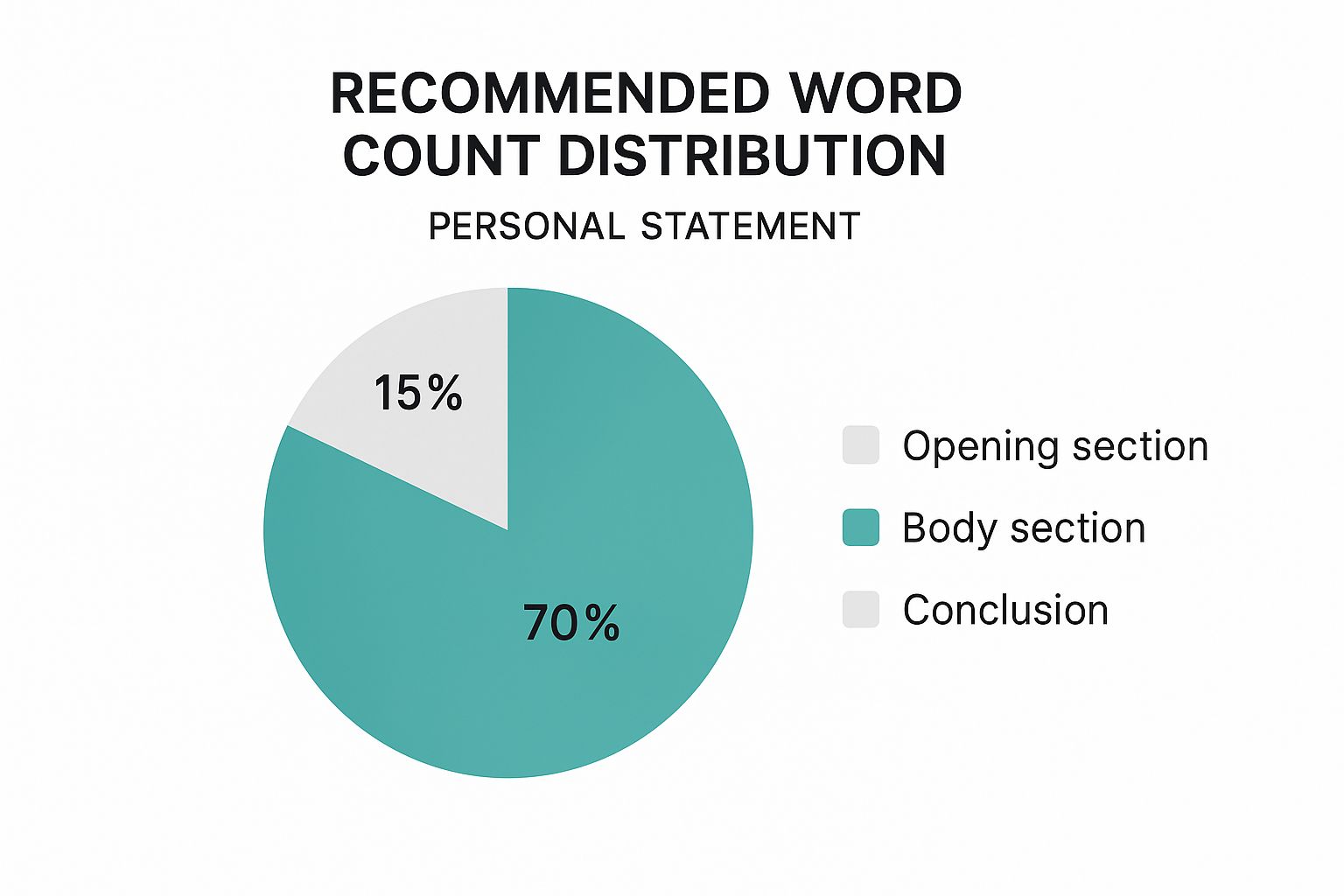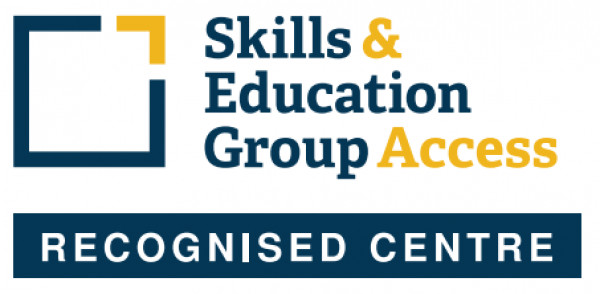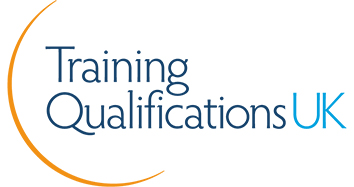
Writing an effective personal statement is your chance to tell a compelling story that connects your unique experiences to your future ambitions. Rather than just being a list of achievements, it's your opportunity to show an admissions tutor who you are and why you are the perfect fit for their course. Getting this right is your first real step towards making that meaningful career change you’ve been dreaming of.
What a Winning Personal Statement Really Looks Like

We’ve all been there: staring at a blank page, wondering where on earth to begin. The trick is to stop thinking about “listing qualifications” and start thinking about “telling your story.”
Your personal statement is the bridge between your past—whether that’s in retail, an office, or volunteering—and the future you’re building. It’s your opportunity to explain the ‘why’ behind your application and let your genuine passion shine through.
This is especially true if you're changing careers. You bring a wealth of life experience that can truly set you apart from younger applicants. The key is framing that experience to highlight relevant skills like resilience, communication, and problem-solving.
To make your statement truly stand out, it needs to be built on a solid foundation. Think of it as having three essential pillars that work together to support your application.
The Three Pillars of an Effective Personal Statement
|
Pillar |
What It Means |
Why It’s Important |
|---|---|---|
|
Authenticity |
Writing in your own voice and sharing genuine experiences that shaped your decision to apply. |
Admissions tutors read hundreds of statements. A genuine voice is memorable and builds a connection. |
|
Relevance |
Directly connecting your skills, experiences, and goals to the specific course you’re applying for. |
It shows you’ve done your research and are serious about this particular programme, not just any course. |
|
Evidence |
Backing up your claims with specific examples. Don’t just say you’re a great team player; describe a time you were. |
Examples provide concrete proof of your abilities and make your story more believable and impactful. |
By keeping these three pillars in mind, you can ensure your statement is personal, targeted, and convincing from start to finish.
Making Every Second Count
You don’t have long to grab the reader's attention. For competitive courses, admissions staff might spend just a short time scanning each personal statement. That tiny window means every single sentence has to count.
This is exactly why a structured approach is so vital. A great guideline to follow is the 80/20 rule:
-
80% of your statement should focus on your academic interests, the skills you’ve gained, and why you understand and want to join this specific course.
-
20% can cover extracurricular activities, hobbies, and personal qualities that back up your application.
This simple rule helps keep your passion for the subject right at the heart of your statement, where it belongs.
The Power of Persuasive Writing
At its core, your statement is a piece of persuasive writing. You're making a case for yourself, arguing why you deserve a place. Many of the principles are similar to creating a convincing application cover letter, where clarity, evidence, and passion are everything.
Your personal statement shouldn't just tell them you're motivated; it must show them. Use specific examples from your life and work to demonstrate your commitment, turning abstract claims into concrete proof of your potential.
Even with changes coming to the UCAS application format, these core skills of reflection and clear communication will always be your greatest assets. It's all about proving you’re ready for what comes next.
Preparing to Write Your Best Work

Before you even think about writing a single sentence, the real work begins. A powerful personal statement is always built on a solid foundation of self-reflection and careful planning. This is your chance to move past generic advice and dig up the unique story that only you can tell.
So many people make the mistake of jumping straight into writing. That's a fast track to a disjointed and confusing narrative. If you take the time to brainstorm properly first, your final piece will be focused, authentic, and hit all the right notes for the admissions tutors.
Uncovering Your Unique Story
First things first, you need to gather your raw materials—all the experiences, skills, and motivations that make you who you are. Don't filter or judge anything at this stage; just get it all down on paper. A simple mind map or even a messy list is a great way to start.
Think about the key moments in your personal and professional life. What challenges have you overcome? Which achievements make you feel genuinely proud? And, most importantly, what has led you to this specific career change right now?
The goal of brainstorming isn't to find the 'perfect' topic immediately. It's about exploring your own history to find the threads that connect your past experiences to your future ambitions. You are the main character in this story—show the reader how you got here.
Once you have a collection of ideas, start looking for patterns. Maybe that difficult customer service role taught you the patience you need for a career in social care. Or perhaps managing that small team project revealed a passion for leadership that fits perfectly with a business course. These connections are the absolute heart of your statement.
Deconstructing the Course Description
With your personal inventory ready, it's time to look outwards. Your personal statement has to prove you are a perfect match for the specific course you're applying for. The best way to do this is to get forensic with the course description on the provider's website.
Seriously, print it out or copy it into a document and grab a highlighter. You're hunting for keywords and phrases that describe their ideal candidate.
-
Skills: Do they keep mentioning "critical thinking," "empathy," "communication," or "problem-solving"?
-
Values: Is there a big emphasis on "community," "lifelong learning," or "professional ethics"?
-
Course Content: Which specific modules or topics excite you the most, and why?
This simple exercise transforms the course description into a personal checklist. Now, you can directly match the experiences from your brainstorming session to the qualities the institution is actively looking for. For a more detailed walkthrough, you can find extra tips in our complete guide to personal statements.
Structuring Your Core Themes
By now, you should have a rich list of personal experiences and a sharp understanding of what the course demands. The final prep step is to organise these ideas into two or three core themes that will form the main body of your statement.
Let's imagine you're applying for an Access to HE Diploma (Nursing). Your themes might look something like this:
-
Developing Empathy Through Lived Experience: Connecting a personal story of caring for a family member to the core values of nursing.
-
Building Resilience in a High-Pressure Environment: Using examples from a previous job in hospitality to show you can handle stress.
-
A Commitment to a Future in Healthcare: Explaining what specific parts of the nursing course you're excited about and how it aligns with your long-term goals.
Organising your thoughts this way gives you a clear roadmap before you start writing. It stops your statement from becoming a boring list of achievements and instead shapes it into a compelling, structured story. If you find yourself stuck at this stage, it can be helpful to look at strategies for overcoming writer's block and unlocking creativity to get your ideas flowing freely.
How to Structure Your Personal Statement for Impact
A great story needs a solid structure. Without it, even the most compelling ideas can get lost, leaving your reader confused. Your personal statement works the same way; it needs a clear beginning, middle, and end to guide the admissions tutor through your journey and leave a powerful impression.
Thinking about structure from the start helps you organise your thoughts and ensures every single paragraph serves a purpose. A well-structured statement is just easier to read and far more persuasive. It shows you're a clear, thoughtful, and organised candidate—qualities every university and college values.
This structure really boils down to three key parts: a powerful opening, a detailed body, and a memorable conclusion. To help you visualise this, here’s a rough guide to distributing your word count.

As you can see, the vast majority of your effort should go into the body of your statement, where you’ll provide the real evidence and detail.
Crafting a Compelling Opening Hook
Your introduction has one job: grab the reader’s attention and make them want to keep reading. This is often the hardest part to get right, so don't be discouraged if it takes a few tries to nail it.
In fact, recent research found that a massive 63% of applicants struggled with writing an engaging opening. This was actually a key factor in the decision to reform the UCAS personal statement system. You can discover more insights about the new UCAS guidelines and see how they aim to support applicants.
The best way to start is by being direct and authentic. Please, avoid overused clichés like, "From a young age, I have always been passionate about…" as they tell the reader absolutely nothing unique about you.
Instead, try one of these approaches:
-
Start with a specific moment: Describe a brief but significant experience that genuinely sparked your interest in the subject. This immediately makes your story personal and real.
-
State your core motivation: Get straight to the point. What's the single biggest reason you're applying for this course, and what do you hope to achieve?
-
Share a surprising insight: Mention something you learned that challenged your perspective and led you down this path. This shows real intellectual curiosity.
Keep your opening concise—just a few sentences will do. Its goal is to set the scene and create intrigue, not to tell your entire life story.
Building a Detailed and Evidentiary Body
The middle of your personal statement is where you truly make your case. This is your chance to connect your past experiences to the skills and knowledge required for the course you want to study. Aim for two to four well-developed paragraphs, each focused on a single, clear theme you identified during your brainstorming.
A brilliant way to structure these paragraphs is by using the STAR method. This technique is perfect for giving concrete evidence of your skills instead of just listing them.
It breaks down like this:
-
Situation: Briefly describe the context. Where were you, and what was the challenge?
-
Task: What was your specific role or responsibility in that situation?
-
Action: What specific steps did you take? Use strong verbs here (e.g., "I organised," "I managed," "I designed").
-
Result: What was the outcome? If you can, quantify it (e.g., "This improved efficiency by 15%," or "It led to positive feedback from ten clients").
This method forces you to go beyond simply saying you have a skill and instead proves it with a real example. It’s the difference between saying "I have good communication skills" and describing a time you successfully calmed down a difficult customer.
By focusing each paragraph on a different theme—like your work experience or academic interests—and using the STAR method, you build a powerful, evidence-based argument that is both convincing and easy to follow.
Writing a Memorable and Forward-Looking Conclusion
Finally, your conclusion needs to tie everything together neatly and leave a lasting positive impression. The key here is not to simply repeat what you've already said. Instead, your conclusion should reinforce your passion and look to the future.
Your conclusion really needs to do two main things:
-
Summarise your core message: Briefly reiterate why you are the right fit for the course, connecting your key skills and motivations one last time.
-
Show your enthusiasm for the future: Explain what you hope to achieve with this qualification. How will this course help you reach your career goals? This demonstrates ambition and a clear sense of direction.
End on a confident, optimistic note. This is your final chance to convince the reader that you are not just a suitable candidate, but an exciting one who will bring real value to their institution. A strong conclusion makes your statement feel complete and purposeful, leaving the admissions tutor with no doubt about who you are and what you can accomplish.
Bringing Your Story to Life with Real Examples

Theory is one thing, but seeing advice in action is what really makes it click. The biggest challenge when figuring out how to write a personal statement is translating your life into a story that an admissions tutor will connect with. It’s all about connecting the dots for them.
So many applicants, especially those changing careers, worry that their background isn’t "relevant enough." This is almost never the case. Your past roles have given you a goldmine of transferable skills; you just need to learn how to frame them in the right way.
Let’s walk through a few real-world scenarios based on popular career paths you can follow with Stonebridge Associated Colleges. These examples will help you find the hidden value in your work history.
From Retail to Nursing
Picture this: you're applying for an Access to HE Diploma (Nursing). For the last five years, your main experience has been managing a busy retail store. How do you make that sound relevant to a career in healthcare?
It's a lot simpler than you might think. Your goal is to focus on the core skills of nursing that you’ve already been using every day, just in a different setting.
-
Communication and Empathy: Don't just say you "handled customer complaints." Describe a specific time you calmed down a tense situation with an upset customer. Explain how you listened carefully to understand their problem and found a solution that made them feel valued. That’s a perfect example of patient-centred communication.
-
Time Management Under Pressure: Instead of a vague mention of working in a "fast-paced environment," talk about juggling staff rotas, stock deliveries, and customer queues during the frantic Christmas rush. This proves you can prioritise tasks and stay calm when things get chaotic – an essential skill on any hospital ward.
-
Attention to Detail: Did you handle the daily cashing up or manage inventory? This shows you’re meticulous and trustworthy, which are vital qualities when you're dealing with patient records and medication.
When you frame it like this, your retail experience becomes powerful proof of your ability to care for people, manage stress, and communicate with compassion.
From Hospitality to Business Management
Now, let's switch gears to an applicant for a Business Management course. Their background is in hospitality, managing a small café. This might seem worlds away from corporate strategy, but the foundational skills are exactly the same.
Your personal statement needs to zero in on the 'business' side of running that café. Put on your business owner hat and highlight your achievements, using concrete numbers wherever you can.
The key is to shift the focus from the daily tasks (making coffee) to the strategic responsibilities (growing the business). Every role has a business element; your job is to find it and highlight it with evidence.
Here’s how you can translate that experience:
-
Project Management: Did you roll out a new menu or a customer loyalty scheme? Frame that as a project. Talk about the planning, execution, and the result (a 20% increase in repeat customers, for example).
-
Financial Acumen: Don't just say, "I handled the tills." Explain how you were responsible for weekly budgeting, managing supplier costs, and finding ways to cut waste, which boosted profit margins by 5%.
-
Leadership and Team Building: Talk about how you trained new staff, organised schedules, and created a positive team atmosphere that lowered staff turnover. This is direct evidence of your leadership potential.
Suddenly, your café job isn’t just about service; it’s a mini case study in business management. For more inspiration on framing your journey, check out our article on what is an example of a good personal statement.
From Volunteering to Veterinary Care
Finally, let’s consider someone with a passion for animals who wants to enrol in an Access to HE Diploma (Veterinary Science). They don’t have any formal work experience in the field, but they’ve spent years volunteering at a local animal shelter.
This is where your passion and dedication become your strongest evidence. Your volunteering is not "just a hobby"; it's solid proof of your long-term commitment.
-
Demonstrate Resilience: Working in a shelter can be emotionally draining. Briefly share a story about an animal you helped nurse back to health. This shows you have the emotional strength for the challenges of veterinary work.
-
Highlight Practical Skills: Even the basic tasks are relevant. Mention your responsibilities, like cleaning enclosures, feeding animals with specific dietary needs, and helping with socialisation. This proves you are reliable, responsible, and not afraid of getting your hands dirty.
-
Show Eagerness to Learn: Talk about what you learned from the shelter staff. Did you observe basic medical checks? Did you learn about animal behaviour? This shows you’re proactive and ready to soak up new knowledge, making you an ideal student.
In all these examples, the secret is the same: look past the job title and focus on the skills, responsibilities, and results. Your unique journey is your biggest asset. Learning how to write a personal statement is simply about presenting that journey in the most compelling light.
Editing and Polishing Your Final Draft
You’ve managed to get your experiences, ambitions, and personality down on the page. That’s a huge step. But the journey of learning how to write a personal statement isn’t quite over yet. The final editing and polishing stage is what turns a decent draft into a truly great one. It’s your chance to make sure every single word is earning its place.
So many people rush this part, but a careful review can catch those small mistakes that might just distract an admissions tutor. Taking the time to refine your work shows professionalism and that you’re genuinely committed to your application. This is your chance to make all that hard work shine.
A Practical Checklist for Refining Your Draft
Editing is about so much more than just hunting for typos; it’s about sharpening your message until it’s impossible to ignore. A good rule of thumb is to aim for around three to seven drafts in total. The first few are about getting the story and structure right, while the last few are all about refinement.
Here’s a simple but incredibly effective checklist to guide you:
-
Read It Aloud: This is probably the best trick in the book for catching awkward phrasing and sentences that just don't flow. If it sounds clunky when you say it, it will be even worse when someone reads it.
-
Get a Second Opinion: Ask someone you trust to give it a read-through – a friend, family member, or a tutor. A fresh pair of eyes can spot errors you’ve become blind to and, more importantly, can tell you if your story is coming across the way you intended.
-
Check for Consistency: Does the tone of voice you started with carry all the way through to the conclusion? Make sure your core message doesn’t get lost or muddled along the way.
Your first draft is for you; your final draft is for the reader. The editing process is about bridging that gap, ensuring your passion and skills are communicated with absolute clarity. Don't be afraid to cut sentences that don't add real value.
Using Editing Tools Responsibly
Grammar and spelling checkers are fantastic, but you need to use them with a bit of caution. They’re brilliant for catching obvious slip-ups but can sometimes miss the nuance in your writing or suggest changes that strip away your personality.
Think of them as a safety net, not a replacement for your own judgement. Run a final check, absolutely, but always make the final call yourself. Your authentic voice is your biggest asset here, so don't let a machine edit it away.
Mastering the Art of Trimming
Personal statements almost always have strict character or word limits. Learning to be ruthless with your own writing is a vital skill. Honestly, every single word has to justify its place on that page.
If you find you’re over the limit, look for opportunities to be more concise:
-
Remove "filler" words: Phrases like "I believe that," "In my opinion," or "I think that" often add nothing and can be cut without losing any meaning.
-
Combine short sentences: Look for choppy sentences that could be joined together to create a much better, smoother flow.
-
Replace weak verbs: Go for stronger, more active verbs. Instead of writing "I was responsible for managing the team," just say "I managed the team." It’s punchier and more confident.
This final stage isn't just about cutting words; it’s about making the words that are left more powerful. By polishing your draft with care, you'll present a final statement that is confident, compelling, and ready to make a real impact.
Start Your Next Chapter with Flexible Learning
You’ve done the hard work and now know what it takes to write a personal statement that gets you noticed. That statement is your key to taking the next exciting step towards a career you can feel genuinely passionate about.
At Stonebridge Associated Colleges, we know that education needs to fit around your life, not the other way around. Changing careers as an adult learner often means juggling work schedules, family commitments, and everything in between. That’s exactly why we’ve built our courses to be truly flexible.
Education That Adapts to You
Imagine starting a new course without the stress of rigid timetables or getting locked into long-term financial agreements. Our flexible subscription model gives you that freedom. You get full access to your chosen course and dedicated support from a qualified tutor, all for one affordable monthly fee.
This approach really puts you in the driver's seat. If things get hectic, you can just pause your subscription and pick things up again when you’re ready. No complex credit agreements, no penalties – just a straightforward way to learn at a pace that actually works for you.
Your ambition to change your career deserves a learning path that supports, rather than complicates, your life. Flexible online study means you can pursue your goals without putting everything else on hold.
Find Your Passion and Build Your Future
Whether you picture yourself in a busy hospital, running a dynamic business, or working with animals, we’ve got a course that can get you there. Our programmes are all designed to give you the practical skills and recognised qualifications that employers are actually looking for.
From Access to Higher Education Diplomas that create a direct route to university to specialised vocational qualifications, your next chapter is waiting. You have the story and the motivation, and now you have the tools to write a personal statement that proves it. All that’s left is to choose your path.
Ready to see where your ambition could take you? You can explore the full range of our online distance learning courses and find the perfect fit for your career goals today. Your future is in your hands—let’s start building it together.
Common Questions About Personal Statements
Even with the best plan, it’s normal for a few nagging questions to pop up while you’re polishing your personal statement. Getting the basics right is one thing, but it’s the little details that can feel tricky. Let’s tackle some of the most common worries to give you that final bit of confidence.
What If I Don’t Have Direct Experience?
This is probably the number one concern for anyone changing careers, but honestly, it’s often a misplaced one. Admissions tutors aren't just ticking boxes for direct, hands-on experience; they're looking for potential, and that comes from your transferable skills.
Your time working in retail, hospitality, or an office has given you a whole toolkit of abilities in communication, problem-solving, and time management. The trick is to show how your past roles have set you up for this new direction. A background in customer service, for instance, is brilliant proof of your empathy and resilience – two skills that are absolutely essential for any health and social care course.
How Much Personality Is Too Much?
Being authentic is crucial, but remember to keep your tone professional and respectful. Showing your personality means letting your genuine passion come through in your writing, not dropping in informal slang or jokes.
Think of it as being similar to a job interview. You want to be engaging and memorable, but you also need to show you’re taking the opportunity seriously. Your enthusiasm will shine through in your thoughtful reflections and excitement for the course much more effectively than it would through overly casual language.
Your personal statement is your professional introduction. Let your personality come alive in the stories you choose and the passion you express, rather than trying to be witty or clever. A sincere, motivated tone will always win out.
Can I Use AI for Help?
AI writing tools can be handy for a quick grammar check or for brainstorming a few initial ideas, but they should never, ever write your statement for you. This piece of writing has to be your own work, in your own voice. Tutors are getting very good at spotting the generic, impersonal style that AI often produces. Think of these tools as a proofreader, not an author.
It’s also worth knowing that application processes are changing. The UCAS personal statement, for example, is moving to a more structured, question-based format for 2026 entry. This is partly because a huge 83% of students found the traditional open-ended format stressful. While the new system is designed to be more equitable, the need for genuine, personal reflection is still at its core. You can read the full details about the UCAS reforms to get a feel for the future of applications.
Ready to put your powerful new personal statement to good use? Stonebridge Associated Colleges offers the flexible, supportive online courses you need to turn your passion into a new career. Start your journey today.




